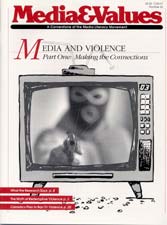Addicted to Violence: Has the American Dream Become a Nightmare?
|
This article originally appeared in Issue# 62
|
At a psychological level, the drama and titillation of violent scenarios serve to create a sense of excitement, potency and significance that is missing from most people's daily lives.
When we consider media violence, we think first of television's increasingly violent content. We fear that a populace incessantly bombarded with the images, sounds and emotions of shootings, bombings and rapes will become desensitized to such violent acts; or worse, learn to think of them as valid responses to life's growing stresses. The evidence suggests these fears are valid.
But media violence also affects us at a deeper and ultimately more problematic level. To make these connections, we must look beyond the literal content on the screen to the subliminal dynamics that animate them, as well as the social context that gives them their power.
Violence as a Drug
An analogy can help. As a futurist, I am frequently asked to address the background and expected developments of various problems plaguing today's world. In talking about the drug crisis, for example, I might comment that while it is most frequently framed as a moral crisis — a problem created by the bad actions of people who should be doing good — I see it more as a crisis of cultural purpose. We find ourselves in times when significant opinions of the population are ingesting substances that mimic real meaning — real excitement, real power, real passion, real spirituality — rather than taking the life risks required to provide meaning as authentic experience.
The dynamics of media violence work in a similar way. At a psychological level, the drama and titillation of these violent scenarios and our identification with their heroes and heroines serve to create a sense of excitement, potency and significance that is missing from most people's daily lives.
Beneath these secondary influences lie effects more directly neurological in nature.
Here, it is less violence per se — behavior driven by anger or aggression — that hooks us to violent programming than the generalized rush of adrenalin we feel in response to violent situations presented to us. As good action/adventure directors know, a car chase or a plane crash, or even just an explosion, can be as effective as a premeditated shooting in keeping our attention glued to the screen.
The addictive power of this generalized stimulation is illustrated all too vividly by a classic experiment with rats. Wires are inserted directly into excitement centers in the rat's brain, then attached to a depressible pedal in its cage. After discovering the connection between the pedal and the pleasure it brings, the rat depresses the pedal with growing frequency. Gradually the animal neglects other activities. In time it even forgets to eat — and starves to death.
Jolts per Minute
Programmers learned long ago that, as with the rat, regular jolts of empty stimulation are the easiest and cheapest means of keeping viewers glued to the screen. Thus, "jolts per minute" (#423) programming has come to pervade not only the action/adventure genre, but nearly every aspect of media. Soap operas and afternoon talk shows prosper through their ability to whip up polarized emotions. And the evening news, sold as television's time for serious analysis, has increasingly become an ever more predictable litany of each day's killings and disasters. Serious information is secondary at best.
While media violence can thus be directly addictive, we must go beyond this awareness to fully understand its deeper dynamics. Addiction on a broad scale requires more than an addictive substance; it requires as well social circumstances that support the addictive response. As we watch our children — and often ourselves — hypnotized by violence on the screen, we have to ask: "Why don't we all cry out in protest? Why don't we just say no?" The question returns us to the notion of a cultural crisis of purpose.
Addiction in individuals occurs when a person stops seeing a reason to risk the vulnerability required for real fulfillment. A drug may be so powerful that it simply replaces the struggle to build a satisfying life. Or sometimes a person's life circumstances make fulfillment of normal dreams and desires unlikely. But usually there is something more fundamental, more at the level of meaning. The person's life story has become inadequate to inspire him or her to live life fully.
Statistics such as the doubling of teen suicide over the last 10 years suggest all too graphically that, for many, our cultural story has become inadequate to inspire full participation in life. We find ourselves in the awkward position of telling youth to 'just say no" while we ourselves are often unable to articulate a vision of the future that deeply and compellingly says 'yes.'
An Empty Dream
The role of cultural purpose in the dynamics of violence — and particularly in the increasingly disturbing phenomena of random violence — came home strongly for me when I  prepared for a number of speeches I made following the April 1992 civil disturbances in south Central Los Angeles. While reviewing the events of those days, I realized that the driving force behind the rioting changed over time. In its early hours, it seemed to be driven mostly by anger and frustration — ultimately the anger and frustration of people who felt they had little chance of winning at the American Dream. But as the violence became more and more chaotic and random in its targets, it seemed driven less by doubts about participants' chances for success in gaining the American Dream than by knowing at some level that even winning would mean little, that the dream itself had become empty. This ultimate despair became a force for destruction.
prepared for a number of speeches I made following the April 1992 civil disturbances in south Central Los Angeles. While reviewing the events of those days, I realized that the driving force behind the rioting changed over time. In its early hours, it seemed to be driven mostly by anger and frustration — ultimately the anger and frustration of people who felt they had little chance of winning at the American Dream. But as the violence became more and more chaotic and random in its targets, it seemed driven less by doubts about participants' chances for success in gaining the American Dream than by knowing at some level that even winning would mean little, that the dream itself had become empty. This ultimate despair became a force for destruction.
We find ourselves in the awkward position of telling youth to 'just say no" while we ourselves are often unable to articulate a vision of the future that deeply and compellingly says 'yes.'
The addicting power of violence — both real and in the media — increases exponentially during times of transition, those times when a familiar story has ceased to provide inspiration and a new one has yet to take its place. At these times, people are particularly vulnerable to using both violence itself and the witnessing of violent actions to inject themselves with excitement, engagement, and influence — feelings lacking in their own lives. And random violence — violence as undifferentiated stimulation — becomes particularly addictive in a new way. Its power to give voice to the feelings of fear and chaos so central to these times while hiding them from us through its empty intensity has a peculiar attraction.
A Two-Part Cure
The cure for our addiction to media violence lies in two related tasks. We must first teach the basics of media literacy to help people distinguish between genuine feelings of excitement born from true fulfillment and the seductive pseudo-excitement of empty consumable stimulation. Successful media literacy education counters people's susceptibility to manipulation by violence's hypnotic effects. It provides both insight into how these effects work and an emotional climate that supports people's natural desire to be in charge of their lives, to escape harm and to avoid manipulation.
The second part of the solution defines the fundamental challenge of our time — to work together to write the much-needed next chapter in our cultural story. Like the drug epidemic, most of the critical crises of our time are really crises of purpose demanding not just revised policies, but new defining metaphors, new ways of talking about what matters. They challenge us to a unique and critical kind of conversation at all levels — in our schools, in community meetings, in government at all levels, in boardrooms, between friends and family members.
Ultimately, those at risk will be able to say no to the seductions of violent pseudo-excitement and pseudo-meaning only to the degree they experience real excitement and real meaning as possible and worth the risk. The deadening attraction of media violence will diminish to the exact degree its potency is countered by a newly mature and compelling collective cultural vision.



